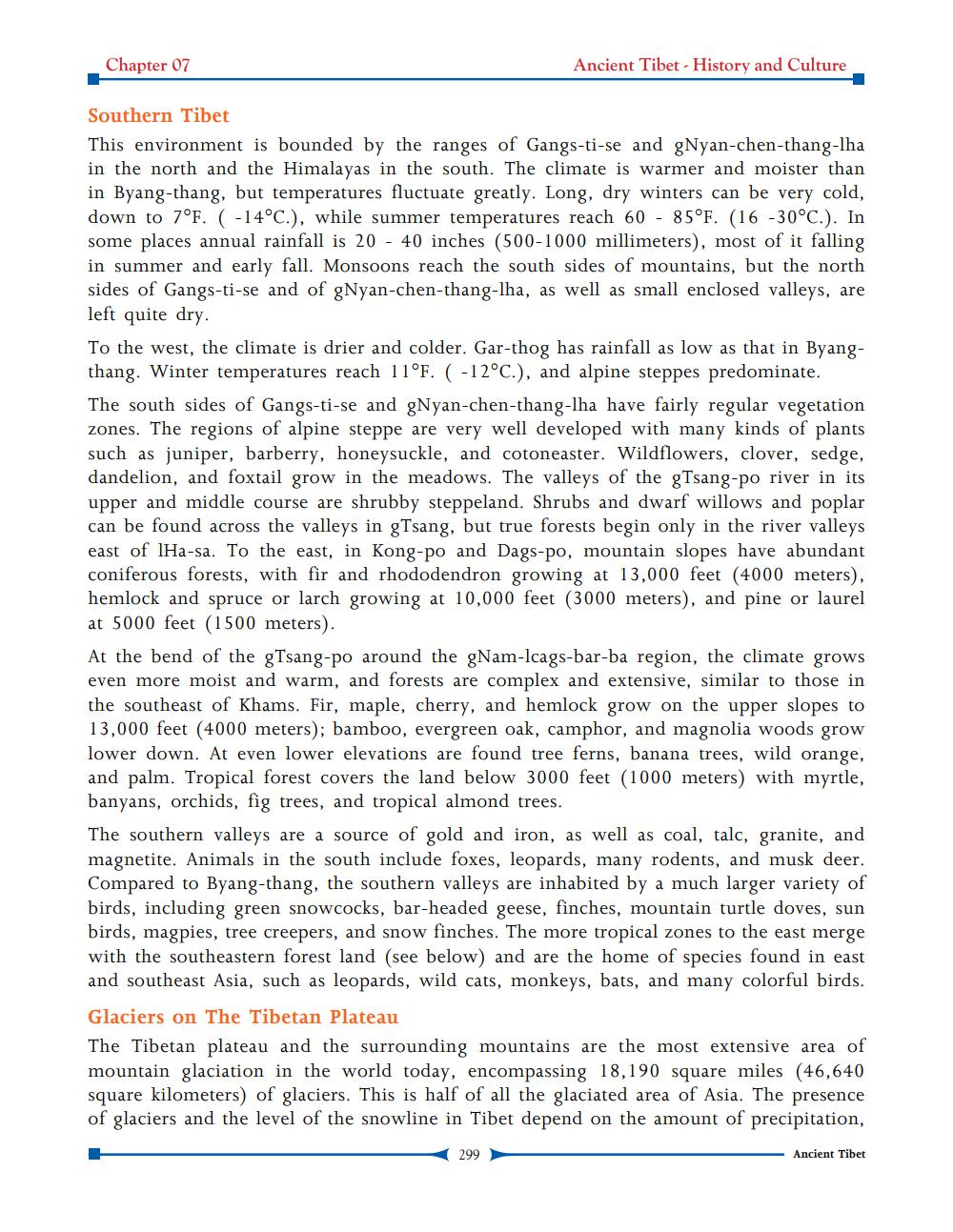________________
Chapter 07
Ancient Tibet - History and Culture
Southern Tibet
This environment is bounded by the ranges of Gangs-ti-se and gNyan-chen-thang-lha in the north and the Himalayas in the south. The climate is warmer and moister than in Byang-thang, but temperatures fluctuate greatly. Long, dry winters can be very cold, down to 7°F. (-14°C.), while summer temperatures reach 60 85°F. (16 -30°C.). In some places annual rainfall is 20 40 inches (500-1000 millimeters), most of it falling in summer and early fall. Monsoons reach the south sides of mountains, but the north sides of Gangs-ti-se and of gNyan-chen-thang-lha, as well as small enclosed valleys, are left quite dry.
To the west, the climate is drier and colder. Gar-thog has rainfall as low as that in Byangthang. Winter temperatures reach 11°F. (-12°C.), and alpine steppes predominate.
The south sides of Gangs-ti-se and gNyan-chen-thang-lha have fairly regular vegetation. zones. The regions of alpine steppe are very well developed with many kinds of plants such as juniper, barberry, honeysuckle, and cotoneaster. Wildflowers, clover, sedge, dandelion, and foxtail grow in the meadows. The valleys of the gTsang-po river in its upper and middle course are shrubby steppeland. Shrubs and dwarf willows and poplar can be found across the valleys in gTsang, but true forests begin only in the river valleys. east of IHa-sa. To the east, in Kong-po and Dags-po, mountain slopes have abundant coniferous forests, with fir and rhododendron growing at 13,000 feet (4000 meters). hemlock and spruce or larch growing at 10,000 feet (3000 meters), and pine or laurel at 5000 feet (1500 meters).
At the bend of the gTsang-po around the gNam-lcags-bar-ba region, the climate grows even more moist and warm, and forests are complex and extensive, similar to those in the southeast of Khams. Fir, maple, cherry, and hemlock grow on the upper slopes to 13,000 feet (4000 meters); bamboo, evergreen oak, camphor, and magnolia woods grow lower down. At even lower elevations are found tree ferns, banana trees, wild orange, and palm. Tropical forest covers the land below 3000 feet (1000 meters) with myrtle, banyans, orchids, fig trees, and tropical almond trees.
The southern valleys are a source of gold and iron, as well as coal, talc, granite, and magnetite. Animals in the south include foxes, leopards, many rodents, and musk deer. Compared to Byang-thang, the southern valleys are inhabited by a much larger variety of birds, including green snowcocks, bar-headed geese, finches, mountain turtle doves, sun birds, magpies, tree creepers, and snow finches. The more tropical zones to the east merge with the southeastern forest land (see below) and are the home of species found in east and southeast Asia, such as leopards, wild cats, monkeys, bats, and many colorful birds.
Glaciers on The Tibetan Plateau
The Tibetan plateau and the surrounding mountains are the most extensive area of mountain glaciation in the world today, encompassing 18,190 square miles (46,640 square kilometers) of glaciers. This is half of all the glaciated area of Asia. The presence of glaciers and the level of the snowline in Tibet depend on the amount of precipitation,
Ancient Tibet
299




